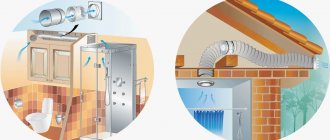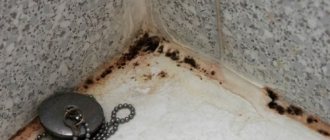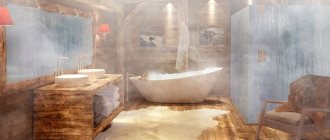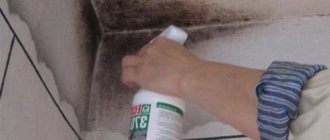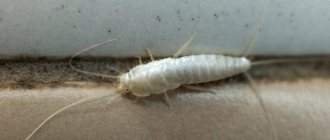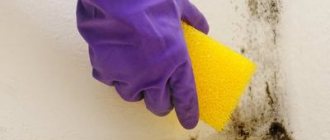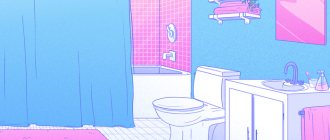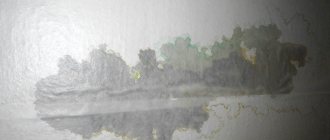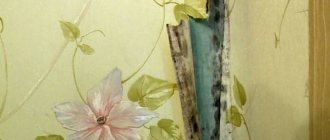Owners of rooms with high humidity and poorly organized ventilation systems are faced with the problem of mold appearing on the ceiling surface. The fact is that the fungus actively grows and reproduces only at optimal humidity and temperature. But surfaces affected by mold fungi should not be ignored, because they pose a threat to the health of household members. If you notice mold on the ceiling in the bathroom, our article will tell you how to get rid of it and prevent fungus from appearing in the future.
Causes of mold in the bathroom
First, let's look at the reasons for the appearance of this microorganism in our houses and apartments. A warm, humid environment is the optimal place for the development of fungal microorganisms. That is why they appear more often in rooms with high humidity (bathrooms). The best protection against this problem is good ventilation.
It is much easier to prevent the appearance of fungus than to try to get rid of it later. In this regard, try to eliminate in advance the causes of damage to various surfaces in the house by mold microorganisms:
- Mold on the ceiling in the bathroom most often appears due to high humidity, so after bathing, always ventilate the room well.
- If the room does not have a properly organized and properly functioning ventilation system, then this also helps to create a favorable environment for the development of the microorganism.
- Fungus on the ceiling surface sometimes appears due to the collection of condensation in this place, which is a consequence of sudden temperature changes.
- A similar problem is often encountered after flooding by neighbors above. Sometimes you don’t even need a big flood, it’s enough for the floor slab to constantly get wet due to poor waterproofing of the bathroom of the neighbors above.
- If there are fistulas in the risers of heating and water supply systems passing through the ceilings, then they become a source of constant humidity and wetting of the ceilings. The same can be said about leaks in sewer systems.
- A leaking roof in a private house also creates a favorable environment for the development of fungal organisms.
Important! Before removing mold in the bathroom ceiling, eliminate the causes of its formation. Otherwise, the fungus will appear again.
In addition to the unaesthetic appearance of the ceiling, mold microorganisms are harmful to health, especially for children and people with weakened immune systems. They provoke various diseases of internal organs, including cancer. In addition, the fungus can invade more and more new surfaces and lead to the destruction of the wooden structures of the house.
Why does mold appear on the ceiling?
Before you start ridding your bathroom of fungus, you need to find out the true cause of its appearance. Then choosing a mold repellent will be much easier.
There are many factors influencing the creation of favorable conditions for the spread of mold on ceilings in apartments:
- High indoor humidity. This is the main condition under which the development of mold gains rapid momentum. And raising the temperature to 20 degrees significantly speeds up the process (especially in rooms where there is a lot of water evaporation), in which the fungus in the bathroom ceiling begins to multiply even faster.
- Malfunctions of the ventilation system. The lack of fresh air flow and circulation throughout the room prevents the timely removal of moisture. Consequently, mold growth accelerates.
- Primary errors at the construction stage are poor sealing of walls and ceilings, improper installation of ventilation and sewerage systems.
- Coldness in the premises during the autumn-winter and winter-spring periods, when proper optimal heating of the room does not occur.
- Use of materials with increased moisture resistance when finishing. Without absorbing water, such products create increased humidity in the rooms.
There are also other reasons why mold may appear on the ceiling. These are careless residents from above who forget to turn off the taps, various leaks in the pipeline system, stagnation, and fistulas in sewer pipes.
Having determined why fungus appeared on the ceiling in the bathroom, you can move on to methods of combating it.
How to remove mold from ceilings and prevent its occurrence
Before removing mold from the bathroom ceiling, eliminate the causes of its occurrence. To do this, do the following:
How to treat the ceiling in an apartment against fungus and how to get rid of mold
- check the ceiling for leaks (roofs, leaks from neighbors, risers of the sewer or water supply system); if a cause is identified, it must be eliminated immediately;
- check the operation of the ventilation system (perhaps the ducts need cleaning, an additional hood or fans need to be installed);
- sunlight kills fungal colonies, so if possible, provide an influx of daylight into the room;
- to prevent the appearance of condensation, improve the insulation of the room (install an additional layer of insulation, hydro- and vapor barriers);
- often a small mold spot indicates the appearance of a large colony of fungus on the back side of the ceiling (be sure to check hidden places and treat them with antiseptic compounds);
- install a dehumidifier in the room, so the humidity will be reduced, which will not allow the microorganism to grow and multiply;
- to eliminate excess humidity in the bathroom after bathing, turn on the forced ventilation system for at least a quarter of an hour and leave the doors in the room ajar;
- Dry wet towels and linen on the balcony, outside or in another room so that the humidity in the bathroom does not increase.
Fungus removal
Now let's talk about how to deal with mold on the ceiling in the bathroom. The appearance of fungal colonies on the ceiling is indicated by black, brown, green and orange spots on the surface. This is where the paint can bulge, peel, fade, and crack. There is a characteristic musty smell of dampness in the room.
Important! It is better to remove fungus on the ceiling in the bathroom when it first appears. This way you will protect the health of your household and reduce the likelihood of repeated damage to the surface. In addition, it is much easier to fight the fungus at the initial stage.
To combat fungal organisms, folk remedies and special chemical compounds are used. Good results are achieved by using an antifungal primer. But it is not enough to simply treat the ceiling surface; preliminary preparation of the ceiling must be carried out.
To work you will need:
- stepladder (preferably with a non-slip rubber lining);
- medium size spatula;
- protective gloves;
- water spray;
- polyethylene film to protect floors and furniture;
- brush or roller for applying impregnation;
- antiseptic solution or antifungal primer.
Follow the following sequence of work:
- Cover the floor, equipment and furniture with plastic sheeting.
- Set up a stepladder, put on rubber gloves and use a spray bottle of water to wet the affected surface. This is necessary for better soaking of the plaster or paint layer, because it will have to be completely removed, because mold grows deep into the porous material and superficial removal will not help.
- After a few minutes, the wetted plaster can be scraped off with a spatula. It is advisable to remove the plaster layer in the area affected by the fungus up to the concrete floor slab. In this case, you need to remove the plaster with a clean surface covering a width of 10-15 cm. This is due to the fact that the pores of the fungus have managed to penetrate into neighboring areas, but have not yet sprouted visible black spots on the surface.
- Now the ceiling surface should dry well.
- Using a roller or brush, apply an antifungal agent to the ceiling. The treatment can be repeated 2-3 times with a break of several hours for the composition to be absorbed. Thanks to this treatment, you can completely get rid of the fungus and protect yourself from its appearance in the future.
- A day later, a new layer of plaster is applied to restore the aesthetic appeal of the ceiling surface.
How to get rid of mold?
The best way to avoid mold is to take preventive measures , but if the problem does occur, it must be addressed quickly and effectively. The most effective and simplest way is to clean the ceiling from fungus-affected whitewash and plaster and refinish it , since it is impossible to remove mold from the ceiling in the bathroom by removing it from the paint or whitewash itself.
The procedure is as follows:
- The entire surface of the ceiling must be moistened generously with water and wait several hours until the layer of whitewash and plaster is completely saturated and begins to peel away from the concrete floor.
- Using a metal spatula, all whitewash is removed up to the ceiling, after which the cleaned ceiling is impregnated with a special antiseptic primer. It is better to treat the seams and joints of the ceiling with the walls with a brush so that the primer covers the entire surface completely.
- After drying, a penetrating primer is applied to this layer.
- Then plastering is done, re-priming with a penetrating compound, and after drying the ceiling can be painted.
A less time-consuming and less expensive way is to use modern special chemicals . But this may not help if the mold is old and thoroughly ingrained.
These drugs include:
- HOMEENPOISTO is a chlorine-based solution that can be used on cement, concrete and even wooden surfaces;
- “Natura Antimantar” - serves both to destroy mold and to prevent its occurrence;
- Biolavatio is the most effective product that, when used in large quantities, can eliminate even old mold;
- “S-Hydrotex-P” is a domestic analogue of the listed imported products.
Some may have a question: if mold has formed on the ceiling in the bathroom, how to deal with it in the case of installed stretch ceilings? In this case, the solution is only to dismantle and eliminate the mold directly on the surface of the main ceiling.
Mold and mildew never “transfer” to a suspended ceiling, because the materials from which such a coating is made are initially protected from this. For this reason, even if mold develops on the main ceiling, it will not be visible behind the tension fabric, and many believe that if the problem is not visible, it can not be eliminated.
Of course, periodically dismantling the tension structure to check for the presence of fungus is also pointless. But if you see that the fungus is moving onto the walls and pipes and all the “traces” lead under the tension structure, the mold needs to be removed, since constant inhalation of spores of such a microorganism can lead to health problems.
Find out how to easily and easily remove fungus in the bathroom and prevent it from reoccurring.
Read in this article about what commercial and folk remedies you can use to get rid of mold on the ceiling in your apartment.
Mold Prevention Products
If you noticed fungus on the ceiling in the bathroom, we described how to get rid of it above, now we will list common ready-made and home remedies for eliminating pathogenic fungal organisms.
How to treat mold and mildew under a suspended ceiling, and the cost of cleaning
Home Remedies
You can prepare an effective remedy to combat mold microorganisms at home. To do this, mix 30 grams of borax, half a liter of hot water and 250 grams of vinegar. This mixture kills fungus, reduces the likelihood of its reappearance and freshens the air in the room.
Some effective home remedies to combat mold organisms include:
- Vinegar destroys about 82% of all types of mold fungi; it is safe for humans, environmentally friendly, and non-toxic. Vinegar deodorizes the air well, is sold in any supermarket and is inexpensive. The product is simply sprayed onto the ceiling and allowed to dry.
- Borax is natural, does not emit toxic substances, and is considered a natural inhibitor and fungicide. Borax purifies the air and is reasonably priced.
- Mold can be treated with chlorine bleach. The composition not only kills organisms, but also removes stains from the surface. But chlorine does not penetrate porous surfaces well, damages some types of coatings and emits harmful fumes. An antiseptic solution is prepared from water and bleach in a ratio of 10 to 1.
- A good alternative to chlorine bleach is hydrogen peroxide. This safe, non-toxic product is used to combat fungal microorganisms, bacteria and viruses. Peroxide removes mold stains. It is enough to spray a three percent solution on the affected areas.
- Ammonia is suitable for controlling fungal colonies on smooth, non-porous surfaces. It is prohibited to mix it with bleach due to the release of toxic gas. To clean the ceiling surface, use a mixture of ammonia and water in equal proportions.
- Safe to use, baking soda kills fungus and freshens the air. Due to the fact that soda absorbs moisture, the surface will be reliably protected from the reappearance of the microorganism. Baking soda destroys those types of fungus that vinegar cannot deal with, so these two products are often used in pairs. For work, prepare a solution on the basis that 10 grams of baking soda are taken per glass of water.
- An effective natural remedy for combating mold organisms is tea tree oil. This is a safe, but rather expensive antiseptic. Take a teaspoon of oil per glass of water.
Ready-made formulations
Among the most popular store-bought antiseptics, the following are worth mentioning:
- Chemical composition called Atlas Mykos. It is used to destroy fungi, moss, lichen and algae. The concentrated solution is suitable for use in any room with high humidity, as well as for outdoor use. Depending on the type of coating to which the solution is applied, it is diluted with two or five parts of water.
- The drug Xiolat destroys mold by destroying it from the inside. The product penetrates deep into the structure of the material and is suitable for treating surfaces made of concrete, wood and brick.
- Dali's water-based composition is used to destroy fungal colonies on any surface. The mixture is suitable for prevention. This colorless solution is sold in 5 liter containers or 600 ml spray bottles.
- The powerful antiseptic Teflex is valued for its safety, environmental friendliness and long-lasting disinfecting effect.
- Spectrum fungicide is suitable for disinfecting wooden, painted and plastered surfaces. Suitable for external and internal work.
- Impregnating primer Snezhka is used to combat lichen, fungi, moss and algae. The solution is suitable for treating brick surfaces, plaster and paint coatings. Snow is used for processing outside and inside the building.
Despite the wide variety of store-bought and home remedies to combat mold colonies, it is better to prevent them from appearing on the walls and ceiling of the room. To do this, it is enough to promptly eliminate leaks and deal with high humidity.
How to fight bacteria using store-bought products
Modern stores offer a large assortment of industrial sprays, gels and other preparations for removing mold spores, which solve the problem of how to get rid of mold on bathroom ceilings. And most of them do not pose a threat to human health.
However, the use of such compositions has some features:
- Products can be produced for both prevention and control of fungus. That is why, studying the information on the packaging is an important point before starting work.
- Antiseptic solutions are best used at the initial construction stage. Penetrating deeply into the structure of the material, such products provide long-term protection to surfaces from mold formation.
- If the ceiling is affected by fungus, then the effect of any product will be high-quality, but short-lived. After a while, black spores will appear on the surface again. Therefore, the fight will be 100% successful only after a complete replacement of the finishing material.
To ensure that the question of how to treat the ceiling against mold ceases to be relevant, you must not neglect basic preventive measures.
These include:
- regular ventilation of the room;
- wiping all surfaces;
- come into contact with water after each use of the bathtub, sink or shower;
- high-quality cleaning and preventive treatment of ceilings and walls with antifungal drugs.
What happens if mold is not removed?
Black spots on the walls are not only an aesthetic problem. They are a threat to human health. The fungus develops quickly. It reproduces through spores, and during this process they are scattered throughout the house. Each of us, by inhaling mold spores, runs the risk of experiencing a deterioration in health. Such microorganisms can provoke the development of complex diseases of the respiratory system, including bronchial asthma.
Mold is dangerous to humansSource www.kras-ref.ru
If you leave the fungus and do nothing about it, over time it will completely destroy the affected surface and damage building structures. There is no point in postponing such an event. As soon as a characteristic musty smell appears in the room, you need to start looking for the first traces of damage. Now, knowing how to remove mold, it will be much easier to fight it.
Folk remedies
The easiest way to get rid of fungus on the ceiling is to call a special service. But sometimes not everyone is ready to pay a high price for it. In addition to the expensive price tag, there is another drawback: after chemical treatment of the premises, you cannot appear in it for about seven days. In the fight against fungal accumulations on the ceiling, you can use folk recipes that are no worse than chemicals.
Important! It is recommended to start fighting mold at the very beginning, when it has not yet had time to grow. This advice will help preserve the health of residents and the aesthetic appearance of the ceiling.
Vinegar
How and what else can you use to remove mold from the ceiling?
Table vinegar 9% and vinegar essence help prevent the appearance of fungus on the ceiling and eliminate its proliferation. This substance has a slightly unpleasant odor, but its vapors are not as toxic compared to bleach and other chemicals.
If the mold has not grown much, then you can only deal with it with vinegar.
How to use vinegar:
Soak a cloth in acid and wipe the mold with it.
For prevention, it is important to go over the fungal growth area with a cloth. Additionally, vinegar can be poured into a spray bottle and sprayed on the ceiling from time to time. In order for the effect to last for a long time, it is recommended to repeat this procedure after 7 days
In order for the effect to last for a long time, it is recommended to repeat this procedure after 7 days.
Peroxide
Hydrogen peroxide can fight even large colonies of harmful fungi. Not only does it help remove dark stains from the ceiling, but it also kills all harmful bacteria and prevents mold from reoccurring.
Benefits of peroxide include:
- non-toxic;
- does not emit harmful fumes when used.
You can buy this product at any pharmacy at a low price. Peroxide is 3% and stronger compositions are 60%; they need to be diluted with water 1:1 or 1:2.
Mode of application:
- If the peroxide is 60%, then it is recommended to dilute it with water before applying it to the ceiling. You need to mix two substances in equal proportions.
- If the mold has grown strongly, you will first have to clean the plaster from the ceiling using a spatula or a wire brush.
- Apply peroxide with a rag or from a spray bottle for 10 minutes.
- The surface of the ceiling is again cleaned of remaining spores.
After treating the ceiling with hydrogen peroxide, you can apply lemon, lavender or tea tree essential oil for prevention.
Soda
Baking soda is a safe cleaning agent and is also an edible form of alkali.
Unlike chemicals, soda after treating the ceiling will not harm the health of people and animals.
Proper use of baking soda against mold:
- The first step is to clean the ceiling from plaster. This must be done mechanically. You can use an iron brush or spatula.
- Mix soda with running water in proportions of 1 teaspoon per 200 ml of water. To enhance the effect, you can add a teaspoon of acetic acid to the solution.
- Dampen the sponge in the resulting solution and wipe the ceiling. You can reach hard-to-reach places with a toothbrush.
Soda must be diluted with water; if you clean the ceiling from mold with one powder, you can scratch the surface.
Tea tree essential oil
Quite often in everyday life this essential oil is used against the spread of fungus. Non-standard use of tea tree guarantees the destruction of mold on the ceiling. The oil contains components that can remove fungus.
For processing you will need:
- a bottle of tea tree oil;
- spray;
- gloves.
Attention! Tea tree oil has a specific odor that disappears within 48 hours.
Mode of application:
- Mix two teaspoons of oil with 400 ml of water and pour the resulting liquid into a spray bottle.
- Shake the mixture and spray it onto the mold on the ceiling. The solution must be applied to the entire affected area, without missing a single centimeter.
- Wipe the ceiling surface with a rag. Repeat the procedure.
In case of severe mold damage, you can treat the ceiling with a solution of 20 ml of oil per 1 liter of water. There is no need to rinse off the product.
The video will tell you how to get rid of mold using folk remedies:

